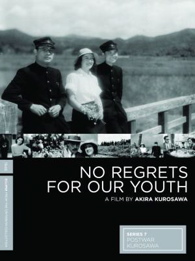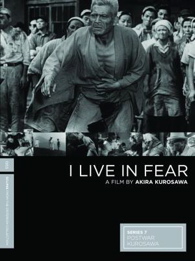| Release List | Reviews | Price Search | Shop | Newsletter | Forum | DVD Giveaways | Blu-Ray/ HD DVD | Advertise |
| Reviews & Columns |
|
Reviews DVD TV on DVD Blu-ray International DVDs Theatrical Reviews by Studio Video Games Features Collector Series DVDs Easter Egg Database Interviews DVD Talk TV DVD Talk Radio Feature Articles Columns Anime Talk DVD Savant HD Talk Horror DVDs Silent DVD
|
DVD Talk Forum |
|
|
| Resources |
|
DVD Price Search Customer Service #'s RCE Info Links |
|
Columns
|
 |
No Regrets for Our Youth |

|
& I Live In Fear Eclipse Series #7 1946 & 1955 B&W 1:37 flat full frame 110 & 103 min. Street Date January 15, 2008 69.95 Directed by Akira Kurosawa |
Criterion's offshoot label Eclipse groups 'lost, forgotten or overshadowed classics' in multi-disc packaging without extras. Previous Eclipse series editions have championed early pictures by Sam Fuller and seldom-screened documentaries by Louis Malle. The new Postwar Kurosawa collection gathers five of the Japanese director's features made between 1946 and 1955. All but the last were made under the stringent censorship of the American occupation. This review looks at the first and the last films in the set. No Regrets for Our Youth is an intriguing story of life under military rule before and during the war. The disturbing I Live In Fear (also known as Record of a Living Being) would likely not have been approved under the occupation, for it takes a critical attitude toward nuclear weapons. As can be expected of Akira Kurosawa, neither picture is a simple endorsement of a particular point of view.

No Regrets for Our Youth (Waga seishun ni kuinashi) is Kurosawa's assured but cautious look back at fourteen years of tumultuous Japanese history, as seen from the point of view of a young woman who marries a dissident opposed to the country's military rule. Made in the first year of the American occupation, the storyline treads on tender wounds to envision the country's future in pro-democratic terms. Little mention is made of the devastation of Japanese cities or the other appalling sacrifices of the war, and the anti-militarist activities of the leading character's husband are never explained. Japanese culture of the time operated on consensus and conformity, so No Regrets for Our Youth's anti-government activism must have been controversial subject matter.
Yukie Yagihara (Setsuko Hara), the privileged daughter of a liberal professor (Denjiro Okochi) has two student-suitors, the conformist Itokawa (Akitake Kono) and the activist Ruykichi Noge (Susumu Fujita). Student and faculty protests against military rule are ruthlessly suppressed (off-screen), with the result that Professor Yagihara loses his job and Noge is sent to jail. Itokawa plays it safe and becomes a prosecutor for the government's oppressive policies. These are expressed only in a scene in which Itokawa tells the politically censured professor that he must stop giving legal aid, even as an unpaid volunteer. Finally released from prison, Noge goes to China to become an 'expert on the region,' although we're not told what kind of expert.
The story avoids historical and political specifics to concentrate on the emotional experience of young Yukie. She begins as an innocent teenager, cavorting with her boyfriends on a hike in the mountains. Yukie clearly prefers Noge to the bland opportunist Itokawa. After years of separation, Noge returns to work in Tokyo and Yukie joins him and declares herself. They marry and live together in the full knowledge that he could at any time be arrested. War with America has begun, and Noge's quiet activities (we never know what they might be) are now considered espionage. Noge is already being watched by a humorless secret policeman (Kurosawa regular Takashi Shimura). Yukie must be grateful for every day she and Noge can be together.
Kurosawa's visuals keep pace with Yukie's feelings, which she expresses in her piano playing and her changing attitude toward flower arranging. Montages depict student upheavals in the early 1930s and a radio announces the start of hostilities in WW2, but the only historical issue given attention is the suppression of academic freedom. Yukie is never fire bombed and her family doesn't outwardly suffer, despite the fact that her father is forbidden to work. In the darkest days of the war, Yukie chooses to work on the little farm of her husband's parents, harassed by 'patriotic' neighbors who brand them traitors and destroy their crops. Yukie's choice to leave her father's house for the hardships of the farm seems a deliberate ploy to present anti-militarist dissidents in a good light. Neither Yoge nor Yukie's father is identified as a socialist or a communist; the historical details are intentionally left vague. No doubt Japanese conservatives resented the film. Perhaps the frequent complaint that Kurosawa was too 'western' also had a political component?
Noge told Yukie that his activities would eventually find public approval, perhaps in ten years. Surely enough, in the film's coda the professor returns to teaching, and gives a speech that honors Noge as the university's most courageous graduate.
We're told that Kurosawa's values were very much in line with the pro-democratic MacArthur occupation. He was soon frustrated by censors that forbade honest looks at unpleasant postwar issues. As demonstrated in Criterion's DVD supplements to Drunken Angel, Kurosawa had to disguise his messages to sneak them past the American censors.
No Regrets for Our Youth also shows Kurosawa in the process of developing his style. The movie has a lyrical, feminine aspect. One particular moment, more interesting than successful, presents Yukie listening at a door. Dissolves join several static shots of her standing in different stylized poses. The odd editorial construction may be an attempt at a visual shorthand meant to communicate the girl's contradictory emotions.

1955's I Live In Fear (Ikimono no kiroku) was released three years after the end of the official American occupation, in the middle of the big nuclear arms buildup of the Cold War. At the time its subject matter was considered very controversial. The Toho studios had just produced the popular Gojira, a film partially inspired by a terrible incident in which a Japanese fishing trawler was exposed to fallout from the Bikini Atoll hydrogen bomb test. The crew was hospitalized and tons of fish were destroyed for fear of contamination. Gojira expressed the atomic threat with a metaphorical monster, perhaps because Japanese culture tended to suppress anything related to Hiroshima and Nagasaki. As late as the 1970s, survivors affected by the bombings were subjected to cruel forms of social discrimination.
In I Live In Fear, elderly Japanese foundry owner Kiichi Nakajima (Toshiro Mifune, in convincing old-age makeup) is certain that an atomic attack is imminent. All of society, including his large family, ignores the possibility of more bombs falling on Japan, but Kiichi is convinced that anyone who remains in Tokyo will perish. Kiichi's solution is to sell his foundry and emigrate with his extended clan to the supposed safety of Brazil, but his relatives have no intention of leaving Tokyo or becoming farmers. They resist by trying to have Kiichi declared mentally incompetent. The dilemma faced by the family dispute mediator (Takashi Shimura again) is that Kiichi Nakajima's anxiety is not irrational. He may be entirely correct about the threat, in which case his is the sane viewpoint, and everybody else is crazy.
Kiichi's sincerity is obvious. He hugs one of his grandchildren, pleading that he wants everyone to move not for himself, but to save the children. Complicating the matter are Kiichi's three other mistresses and their families that depend on Kiichi for support. Kiichi considers them greedy and disloyal but he wants them to come to Brazil as well. Kiichi's house is definitely not in order, which may be Kurosawa and his co-writers Shinobu Hashimoto and Hideo Oguni way of saying that postwar Japanese society has been constructed on an unstable (radioactive?) foundation.
I Live In Fear is first a social drama, but it's also a political science fiction film. It addresses the effects of a new kind of existential anguish borne of the knowledge that civilization could be wiped out at any time. When one of his sons explains that Brazil would also be destroyed in a nuclear war, Kiichi refuses to listen and takes extreme measures to force his family's obedience.
The film has been resolutely naturalistic up to this point. The atomic threat has been remote and invisible, an abstraction. The final moments of I Live In Fear express Kiichi's terrorized madness from within. In a situation with odd parallels to the conclusion of 2001: A Space Odyssey, he becomes 'a prisoner on an alien planet'. For just one shot, Kurosawa poetically creates a terrifying vision of the destruction of an entire world, a subjective apocalypse. The impact is entirely different than the similar planetary fireballs seen in the American science fiction movies This Island Earth and Forbidden Planet. Kurosawa follows this with a neutral but potent coda on a stairwell that may allude to the fate awaiting the children Kiichi wants so badly to save. Is Kiichi's grandchild sleeping peacefully? It's an impressively economical art-film ending.
Kurosawa's film was not an international success. It passed mostly unmentioned in America, just one year after the director's celebrated Seven Samurai. Four years later, Stanley Kramer's On the Beach would dramatize the issue of nuclear oblivion for the cinema mainstream: atom war is unsurvivable madness, and society's only option is to 'put its house in order.' But the humanist Kurosawa was there first.
We immediately accept Toshiro Mifune as a stubborn, emotional senior citizen, and the rest of his clan do well in their supporting roles. Takashi Shimura's family mediator watches in horror while Kiichi, mesmerized by the atomic fire of sunlight in a window, describes a private world of cosmic doom. I Live In Fear is one of a series of bold science fiction movies that take the premise that nuclear destruction is inevitable: Five, These Are the Damned, The Day the Earth Caught Fire.
Eclipse's transfers of No Regrets for Our Youth and I Live In Fear are in quite good shape, even without the added digital cleanup enjoyed by more expensive Criterion releases. Subtitles are clear. No extras are included but each disc comes in a Slim Case with a cast list, technical specs and brief but expert unattributed liner notes. The discs are not available separately.
On a scale of Excellent, Good, Fair, and Poor,
No Regrets for Our Youth &
I Live In Fear rate:
Movies: both Excellent
Video: both Excellent
Sound: both Excellent
Supplements: none
Packaging: Slim cases in card sleeve
Reviewed: January 3, 2008
Reviews on the Savant main site have additional credits information and are more likely to be updated and annotated with reader input and graphics.
Review Staff | About DVD Talk | Newsletter Subscribe | Join DVD Talk Forum
Copyright © 1999-2007 DVDTalk.com All rights reserved | Privacy Policy | Terms of Use
|
| Release List | Reviews | Price Search | Shop | SUBSCRIBE | Forum | DVD Giveaways | Blu-Ray/ HD DVD | Advertise |





